By Sheri Candler
As a result of my recent trip to Europe to participate in the annual FERA General Assembly and Sheffield DocFest, I found some great new independent film resources I would like to share. Sometimes we get too focused on North American resources so it is good to pull in useful information from all over the world. This will be a series of posts over the next few weeks that highlight these new services. First up, Assemble
Assemble (formerly MovieSparx) is a tool for filmmakers and distributors who want to ease the headache of building audiences and selling films on the web. It is clever software that creates and manages your web-presence, gathers and tracks your audience and provides a sales mechanisms to sell your film and related products. I spoke with Founder James Franklin about how the software works.
What made you want to build this? What need did you see in the industry that wasn’t being fulfilled properly?
JF: Simply put – we felt that the vital online presence for a film was almost always a hit and miss affair. Film websites are too often rubbish and do the film a disservice.
About 8 years ago I founded a London based design studio working just for indie film projects. We ran a lot of promotional campaigns for films around the world and learnt an enormous amount over some very high profile projects. Whilst doing this, and when I would speak at festivals about what we learnt, the same questions and problems would come up from filmmakers over and over again.
The main problem was that although everyone agreed that promoting a film and finding an audience online was important and a great opportunity, the reality was that it was very time consuming, had a steep learning curve and was a prohibitively difficult and painful struggle. Just to make matters worse, the budgets were always too small for creating the necessary marketing assets and the tools available at the time had to be hacked by techies to work for an indie film. Generally the assets for each film project – website, widgets, mailing list, shop etc – would be about 70% the same as every other project and about 30% unique. But each time everyone would have to work hard to just get that 70% out the door – we and the filmmakers felt like we were constantly re-inventing the wheel. And so we decided about 3 years ago to create a web-tool that would power these elements out of the box – film website, online shop, widgets etc. It was going to be easy, efficient, flexible and beautiful. We would also pour our knowledge and experience into the system so that best practice was baked into it from the beginning. The very first release was at SXSW in 2010.
There are a few guiding principles we’ve stuck to. Firstly, that it’s always in the filmmakers interests to help promote the film direct rather than promote yet another platform – it’s all about the film project not us. Secondly, that the production team are always the most committed and passionate of advocates and with the right tools and experience can do the best job of promoting and selling the film. Lastly, we understand the importance of the film’s marketing materials /key art / branding – this is what really sells the film and is very important online. Anything we make has to work with the branding and be both functional and well designed.

What does Assemble do for productions? Walk me through the steps all along the way of a production using Assemble from conception of a film to distributing it. Are there some example films at different stages? Describe what they are doing.
JF: We provide the best possible web presence that adapts to each stage of a film. That web presence includes the film website, branded trailers & embeddable widgets, facebook apps, a shop and other important modules. Each Module is made just for film so it works exactly as you would expect out of the box. For instance, adding an award adds a laurel to the website. Each module works with the others, so the shop can appear in Facebook and the trailer for instance. Each of those modules adapts depending the stage the project is at – so in development, it makes the most of the one photo and short synopsis you often start out with. Then the modules adapt for fund-raising or crowd funding, production, festivals and finally distribution. Lastly each module adapts by country so that it can properly support different territories being at different stages – ready for download in the USA but in theatrical in Australia – without interfering with each other.
Currently the modules are:
– Website
– Blog
– Shop
– Widget / Branded Trailer
– Facebook page app
– Screenings
– Mailing List
– Sign-up for media
– Crowd-Funding support
– Gallery
– Awards and Laurels
– Reviews
There are too many features and options to go through everything in detail. But to give an example about how this this works just for film and is designed to be more efficient, take a look at the screenings module. This handles events and screenings either as part of a theatrical release or at festivals. Usually screening dates and times end up on a single page which has to be constantly updated and is hard to find or a film relies on a potential audience remembering at a later date.
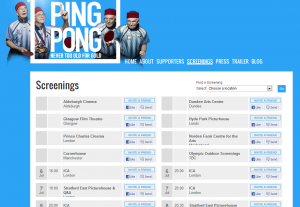
With Assemble, once the production team have entered an event or screening’s details into the back end it appears automatically, in chronological order across all assets – on the website, the trailer, in Facebook and so on. It can be automatically added to the Facebook page as an event for people to share with others. People can even send it to a friend as an invite, or share it to social networks. It can even set up a reminder for you so you’ll get an email the day of the screening. If there’s a screening near you it will flag up on the website home page. When a screening date has passed it’s automatically added to the past screenings. We can even supply a feed of data for partners.
Of course, if there isn’t a screening near you, you can demand one with a simple form or if available, you can set up semi-theatrical or community screenings and sell screening licenses. All of this works straight of the box.
We’ve also worked hard to never lose a potential customer. For instance, if someone in Canada wants to watch the film but it’s not available on DVD or for download yet, rather than giving the unhelpful message ‘this is not available in your region,’ the system will automatically work out an alternative (it may be on at a festival near them, or available from a distributor, or on Amazon – we can route them through to wherever is best). At the very worst, if it’s not available at all to them we can get them to sign up to the mailing list or demand it.
Some example sites at each stage are:
How Far Is Heaven – a simple film website
The Spirit Level – integrating with IndieGoGo
Planeat – shop with downloads and merchandise
Just Do It – powering the shop only alongside a VODO release
Black Gold – long tail of distribution (the film is from 2006)
Europe Loves Cinema – a site with a slate of films
Tigerlily Films-a production company site with many films
As the above all geo-detect, the design changes depending on where you are visiting from.
Is the software mainly built for one title at a time or for a production company in the long term?
JF: It works well for both. The system really comes into it’s own when you run a production company or distribution website and your slate of titles off the system. They all integrate together and save a lot of time and work as well as collecting all the valuable data across the whole lot. That is key, if production companies are to thrive in the
future they must take ownership of their audience data and take it with them to the next project. That way it gets easier every time. Only Assemble can make that part happen.
What advantage would it be for a filmmaker to use a distributor to access this since your site says it is for distributors as well?
JF: It’s a flexible system and so will work for both individually. Ideally, the production team should be on the system from development and running even a basic web presence from the beginning, that way they can start to take control online. And the big advantage for a production team is that our tools work with even the most complicated rights and distributor structure.
When Assemble says it builds websites, is that on the production’s own URL or is it through your platform as a 3rd party?
JF: We power websites for films, much like wordpress powers blogs. You can use your own URLs with the system. The design for each site can be done either through us as a customised project or by a third party designer. The idea is that it’s as flexible and beautiful as possible whilst still being easy.
The description says it builds an embeddable trailer. Do you mean it makes a trailer built by the production embeddable? Why wouldn’t we want this on Youtube instead where we can track views and where they come from? Does Assemble do that too?
JF: We’ve made a very flexible widget that acts as a branded trailer. We think it’s very important to use Vimeo and You Tube as part of a campaign and so we use these to provide the trailer video – You Tube and Assemble play well together. The widget then ‘wraps’ around the Youtube video to create a branded trailer which also can hold extra modules like the shop, a watch the film page, twitter feed, blog, screenings and so on. And you still get your view count up and can track who’s watching it with You Tube.
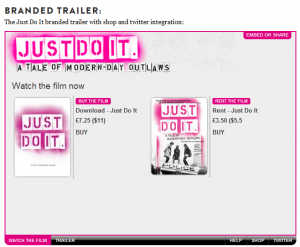
Does Assemble provide training on how to use the system? For many indie productions, this whole process of building an audience and selling directly is completely unknown so how does Assemble help demystify the process?
JF: Yes, we provide training. We’re also adding a series of how-to videos to help things. We also hope to add more general videos on how to make a success of the project using Assemble.
Does Assemble help market the projects or is it only a tool to use by film productions themselves? Would the audience ever come to Assemble or are you more a B2B?
JF: We are not another platform. We are a B2B business, we don’t want to build a relationship with a project’s audience, rather we provide the tools to enable the production team to do that. However, we do help market projects in various ways and we can advise on how to do this as we’ve many years experience at this. One of the key ways a film can market itself online is firstly through social media sharing and secondly affiliate networks.
Assemble heavily supports sharing with social media and building an affiliate network. We help advise people if needed on how to make both of these work hard for a film project. For example, we have by far the most flexible and innovative affiliate tracking system, you’re not tied to one rate and can offer different percentage kick-backs. We find discount codes can work just as well and sometimes better. In addition, we are constantly innovating and testing, then putting what we learn back into the system.
When you say you sell downloads, what makes those downloads disabled to be reuploaded on the internet? Is there a mechanism for hampering that activity?
JF: If a project sells DVDs then these can be easily ripped too. We do review for Youtube and download links. Our own download mechanism can alert us if there are excessive downloads on a single link. We think the pricing of downloads should mean that for a potential customer, it’s easier to just buy the download rather than have the hassle of finding the torrent or download link. People who would pay generally prefer to pay honestly, thats the best way to stop piracy eating revenue.
Orly Ravid July 10th, 2012
Posted In: Digital Distribution, DIY, Facebook, Marketing, Social Network Marketing
Tags: Assemble, European independent film, film distribution, film marketing, film promotion, independent film software, James Franklin, low budget independent film, MovieSparx, selling films on the web, Sheffield DocFest
*This is Part III of “If I Were a Filmmaker Going Sundance…”
Post Sundance what I have to say is this: there were more deals done since I started tracking them along with the rest of the industry so for more deal counting and analysis please refer to that blog post.
But thank you Fox Searchlight, TWC and Oprah for injecting the biz with just the right amount of adrenaline to keep it dreaming big; we hope you’re buying big next year. What else is new? Focus has an emerging digital distribution initiative, Amazon is giving Netflix a run for its money (or not, depends on who you talk to)…. everyone is waiting on Wal-Mart to see how much voodoo VUDU can conjure up and SEARS and KMART are in the digital space just in case you though big retail was dead. Blockbuster is still for sale. Google’s stock price is high as ever and Apple is not going down any time soon judging from its 130,000,000 credit cards on file (and that was just the last time I checked) even though some speculate it will meet its match.
So now that there are almost as many digital plays as they are films (hahahaha of course not literally) how can we distinguish them? TERMS and MARKETING. I have made much fuss about terms before (how long, how many rights, fees and above all, what are the splits between platform/ service and aggregator/distributors).
We hope that filmmakers and their team build community and buzz around their films and start engaging audiences and potential audiences well before and leading up to and following the first public exhibition of their films. But after a distributor or aggregator comes on board, then what? What do they do for the fees, other than the selling and servicing of the film and its assets to the platforms / services.
Here is an overview of what a few companies do to market films for home entertainment release, either DVD & DIGITAL or just DIGITAL, and mostly in their own words:
FILMBUFF
“FilmBuff is an established leader in the development of innovative release strategies, digital merchandising and promotions. Our strong retail relationships allow us to emphasize merchandising and promotional placement on all platforms and video portals. Our internal marketing builds custom outreach programs to build audience awareness and activate the online communities that are ideal for each film. Custom promos and features on FilmBuff’s social media networks across Facebook, Twitter, YouTube and a host of online video portals work in concert to ensure that films reach the widest possible audience.”
Our dedicated programming and marketing teams will:
• Design a custom release strategy for each film across all digital platforms
• Work directly with online stores on a weekly basis to gain featured digital merchandising. Some examples of recent featured merchandising and promotions below:
–Exit Through the Gift Shop on iTunes
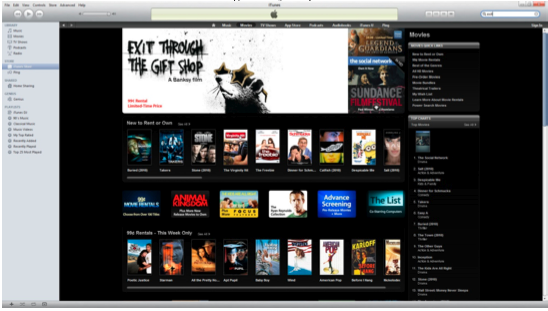
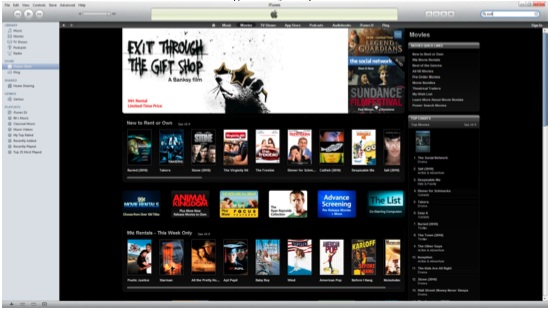


–Collapse on XBox
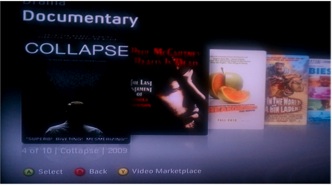
–One Too Many Mornings on Hulu

–Cemetery Junction on Charter

• Build a public relations program to drive audience awareness through national & international press and blog coverage.
–Nice Guy Johnny on AOL Video
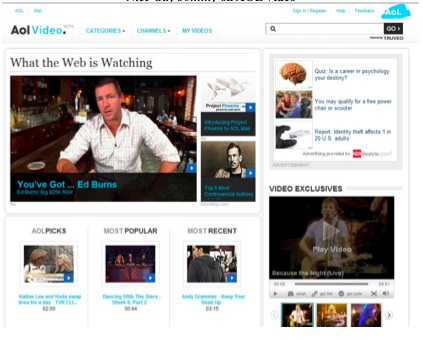
• Execute custom outreach programs to activate and engage the online communities that are ideal for each film.
• Implement online promotional campaigns and features leveraging FilmBuff’s expanding social media community of movie lovers on Facebook, Twitter and Youtube and others. The community now includes 25K+ engaged fans, followers & subscribers.
–Savage County on Veoh
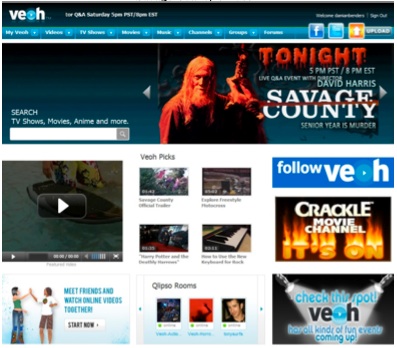
• Feature the film in various areas on our website (www.filmbuffondemand.com) which drives users and fans to digital transactions. The site features video clips, industry content, guest blogs, film extras and links to all portals where the film is available. The site currently receives an average of over 20K+ page views per month.
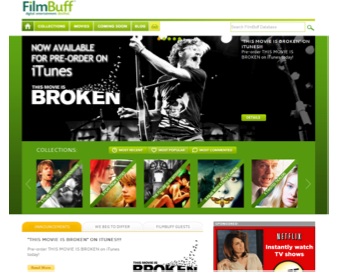

NEW VIDEO
“New Video’s suite of marketing services for films released on DVD, Blu-ray, digitally and on-demand includes:
Direct contact with retailers and platforms for developing and supporting in-store placements and point-of-sale promotions. (TFC notes: They have a lot of DVD volume so their relationships are more valuable than a filmmaker can get on their own dealing with the retailer).
A full-time in-house public relations team directing outreach to national and regional print, online and broadcast media for both industry and consumers-
Collaboration with partner organizations to drive grassroots awareness; a custom affiliate program for DVD sales referrals.
* Best practices to reach existing fan bases online and off with a solid emphasis on social media. * Strategic advertising to maximize ROI. * Promotion at consumer and trade shows.
The mission of New Video is to leverage 20 years of distribution and marketing experience to provide the broadest possible reach across all distribution channels, while raising awareness through major press, grassroots organizations, and everything in between. Titles we’ve distributed and marketed include GasLand, King Corn, Autism: The Musical, Wild Parrots of Telegraph Hill, Bob Dylan: Dont Look Back, Dr. Horrible’s Sing-along Blog and The Secret of Kells. We collaborate with filmmakers, create custom marketing strategies and share our best practices to build on the momentum they have developed over the life of their project. With expert in-house publicity services, our campaigns cover long lead press, short lead, online, industry, and consumer press outlets (both national and regional, in print, online and broadcast media). Our press releases are media-rich and social media-ready for posting and sharing, and we offer next-gen screener service for press review. We have a proven track record in leveraging talent to maximize press and promotion through marketing opportunities such as podcasts and exclusives. We have a hands-on, strategic approach to grassroots marketing, and we employ social network marketing through our own presence on Facebook and Twitter, and through coordination with supporters’ social networks. We prize our longstanding relationships with store merchandising teams, and add enormous value in our ability to customize and create in-store marketing strategy, such as thematic shelves, customized artwork, and priority placements. We collaborate on selective online, print and radio advertising to strategically improve ROI through targeted buys, and we build opportunities around media events, consumer and trade shows to further press coverage and consumer awareness for a property. We complement these practices with a custom affiliate program for DVD sales referrals to incent partner organizations online. New Video is committed to building and maintaining buzz organically, through extended campaigns, early editorial pitching, and social outreach. We communicate with consumers through our website and blog, social media, and a newsletter reaching 15,000 subscribers.”
TFC NOTES: New Video is a key iTunes aggregator not only for its own titles but for many traditional distributors and even IndieFlix and Indie Rights and TriBeCa Films (remember filmmakers, always ask the questions that help you know how many middle men there are in any given category of distribution). I know that on the ‘Social Media Outreach’ front for iTunes releases for example, New Video sends out social-media releases with images & clips to sites such as Digg, Reddit, Stumbleupon and they post release on PR Distribution sites such as ClickPress, i-Newswire, eCommWire, The Open Press. From past experience we know they do a feed-based announcement made available on Google blog search, Technorati, Yahoo! News, Topix, tagged with keywords for easier discovery. New Video does email marketing to its subscribers as well and Trailer or Clip Tagging Promotional clips tagged with “Now Available on iTunes” and syndicated to top video sharing sites (e.g. YouTube, Yahoo!, MySpace, Google, Revver, Dailymotion, Blip, Veoh). They monitor and post reviews in-store Individual reviews posted about the content. On the online grassroots outreach front, they connect to digital portals; targeting topical, genre and talent fansites and blogs and service those with press release and special offers (exclusives, clips, contests, review copies). And they work fans and friends via the social networking sites. (TFC notes: on Facebook New Video as a company only has a little over 1,700 people. The page is largely used to promote titles, not facilitate dialog as Sheri Candler observed.).
WOLFE VIDEO
“25 years developing relationships with national retailers, VOD companies, the press and media, film festival programmers, LGBT organizations and our vendors. Over 25 years building traditional and electronic mailing lists, plus a wide social media presence. Wolfe believes that the key aspect to being an effective Distributor is marketing. In the absence of this expertise, a distributor is merely a middleman. Wolfe is widely known for mainstreaming films with gay content. The most invaluable asset Wolfe brings to filmmakers is experience. Wolfe has over 25 years developing relationships with VOD companies, DVD retailers, niche and traditional media, film festival programmers, broadcasters, LGBT organizations and our vendors. Wolfe has one of the largest channels in the gay niche market which includes traditional and electronic mailing lists and a wide social media presence.
One of Wolfe’s most notable assets is its direct access to gay consumers; better known as WolfeVideo.com. The website supports heavy traffic and is widely known as a commerce site for gay feature films. It should also be noted that Wolfe does not sell adult product, so the website is accessible for many audiences. WolfeVideo.com is supplemented by the QMovieBlog.com and Wolfe’s social network strategy includes a variety of ongoing campaigns across all major platforms. Wolfe has a particularly substantial and active following on Twitter, Facebook and YouTube; for example Wolfe’s work on Were the World Mine generated nearly 100K views on YouTube alone and the famous re-release of Desert Hearts promotion generated over 847,000 views! Wolfe’s direct to consumer assets also include significant opt-in mailing lists via email and traditional snail mail, which continues to be a strong sales tool for the company and its products. (TFC Notes Wolfe’s Facebook page has 3,368 likes).
Sales and marketing via mainstream outlets is key to the success of Wolfe films. Wolfe leverages client relationships with VOD, EST and DVD retailers to further market films. Strategic partnerships bring Wolfe’s films front and center in programs such as the Gay Pride month feature on the home page of iTunes, Internet promotions with Xfinity & dominant presence with DVD retailers such as Amazon.com. Wolfe has also engaged companies like Sony to develop marketing campaigns. The Sony Ebridge program was designed to add value to the DVD. E-bridge gave consumers cool stuff like the chance to win a trip to Australia. It also offered advertisers unique consumer access they would otherwise not reach.
Other clients that partner with Wolfe promotions include hundreds of non-profit organizations nationwide such as LGBT film festivals and political orgs like GLAAD. These organizations work with Wolfe to both screen films for hundreds of consumers and promote the subsequent VOD & DVD releases. These relationships expand consumer outreach and do the good work of promoting the important work of non-profits.
Publicity is a major focus in every Wolfe campaign. Wolfe’s publicists (not in-house) facilitate reviews, interviews and other coverage for all Wolfe releases across a wide range of media outlets from national and regional print publications to blogs and websites. Broadcast networks also work with Wolfe on publicity and marketing. For example, the Logo Network is presently airing Wolfe PSA’s to educate consumers about the effects of piracy featuring actors from Wolfe films.
Additionally, they not only market films on the Wolfe label, but work extensively with larger labels such as Sony, Universal, Fox, and Showtime to name a few. Every successful distributor with gay content has hired Wolfe to support their products. Wolfe has a “soup to nuts” approach to film marketing and they work hard to reach millions of consumers for every release.”
INDEPENDENT LENS
“Independent Lens has a strong social media community including nearly 70,000 engaged Facebook fans —the largest of all PBS primetime series, second only to Antiques Roadshow. Independent Lens social networking and online impact: Independent Lens believes social networking is one key component to reaching new, younger and more diverse viewers for our broadcasts, engagement work and online distribution.
Independent Lens is the second most popular PBS series on Facebook. We post daily, and our posts average 55,000 impressions each. We receive an average of 100 interactions (Likes + Comments) on each post. This engagement rate ranks first among PBS series and means that 5 out of 6 of our fans see each post.
(e.g. their The Calling Livestream event from the Chicago Art Institute in December 2010 attracted more than 3,000 viewers on their Livestream channel on their Facebook fan page.).
We have more than 11,000 followers on Twitter.
We post three or more new Blog postings each week, and they feature interviews with the filmmakers, documentary news, dispatches from filmmakers in the field, live chats with filmmakers and the subjects of their films, and more.
In the first quarter of our current season, Independent Lens had 18,000 page views from more than 15,000 unique visitors.”
GRAVITAS
“With there being thousands of films available in the VOD marketplace, here are four ongoing tactics we use to raise the profile of Gravitas films:
1. Traditional PR- As this The Wrap article shows we believe it important to convey to the industry and entertainment enthusiasts that Gravitas continues to innovate in VOD. In this instance, we will be releasing American: The Bill Hicks Story “day and date” in theatres and on VOD in April. This is a film was adored when it screened at SXSW in 2010 and having pre-release PR supporting the film will help us get wide carriage in 100 million North American VOD homes and marketing support from cable and online operators concurrent with the film’s debut.
We have an outside PR firm on retainer and we also do PR/marketing in house. None of these expenses are charged back to the filmmaker. We work in house, w/ our PR firm and with our Licensors to ensure appropriate messaging is being conveyed. Good reviews are crucial, but of paramount importance is letting the Licensor know when and where the film are being played in VOD. To this end, we communicate with our Licensors every time their film is on a new VOD platform.
Here are a couple recent links to coverage on IFC.com
http://www.ifc.com/news/2010/10/2010-holiday-movie-guide-online-vod.php
http://www.ifc.com/news/2011/01/winter-preview-2011-dvds.php
2. VOD Guide Optimization- As you know, there are over 100 cable, satellite, and telco operators in North America and each operator has their own VOD guide characteristics. As a result, we spend considerable resources internally making sure that our films are mapped so that customers can easily find them. As a result, we have Slingboxes set up in homes all across North America where we can remotely use our office internet connections to peer in to the cable boxes of friends and family to make sure our films are in as many VOD guide folders as possible. The enclosed images shows the layout of 8 different large operators. Our goal is make sure our films show up 4-5 times within each operator VOD storefront in folders frequently called “New Release”, “All Movies A-Z”, “Indy Films”, “2 Day Rentals”, “VOD Premieres”, “In Theatres”, and the appropriate genre categories like “Documentary” or “Comedy.”
Almost each guide (aka UI or User Interface) is a little different and we monitor as many of the UI’s as possible to ensure that we are aware of any guide changes that we should be taking advantage of that would be appropriate for our content so that it is merchandized appropriately. We do this for all of our licensed content.
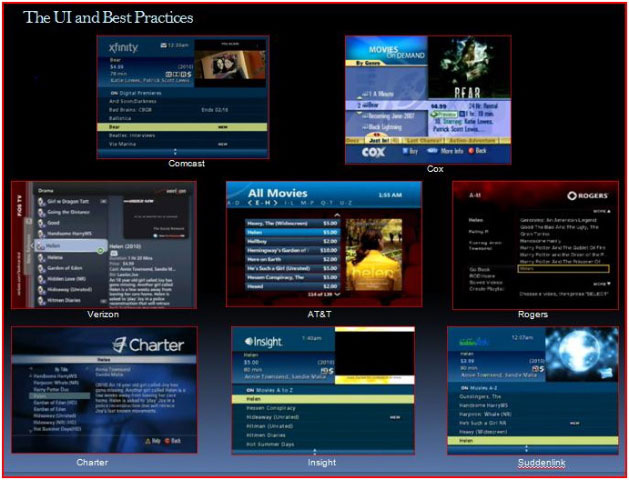
3. Online Editorial Outreach: Gravitas’ marketing team has a monthly dialogue (including sending DVD screeners) with dozens of websites and bloggers that cover independent, genre, and new VOD content including:
IFC.COM
On Demand Weekly
Hammer to Nail
Twitch Film
Film School Rejects
Gordon and the Whale
28 Days Later Analysis
Fangoria
Dread Central
Arrow in the Head
VideoScope Magazine
Horrorphilia
Bloody Disgusting
Here are some recent samples:
http://www.ifc.com/news/2011/01/winter-preview-2011-dvds.php
http://ondemandweekly.com/blog/article/ip_man_-_on_demand/
4. Online and Social Media- Each month we host monthly marketing calls with filmmakers to help implement and grow the online presence of their film prior to and after VOD debut date. Here are just a few examples:
- Gravitas Website-We run on ongoing Film Spotlight section off of our home page where we interview writers and directors of Gravitas films currently in VOD release. http://www.gravitasventures.com/films/
(TFC notes: no info on site traffic and Sheri Candler noted that Gravitas themselves only have a little over 500 people on their own FB page and almost no engagement from fans; few likes, few comments on the material posted there.)
ORLY asked: “Do you have any plans to expand your social network marketing? Any community engagement you want to speak to? I say this because for example Independent Lens does this very well, but most distribs and aggregators don’t. Since you mention it, if you have anything to say about it please do”.
GRAVITAS answered: “To the extent that our social media sites continue to grow, yes, but it’s equally important and effective to spread best practices with our Licensors. i.e. If Gravitas licenses a film with a FB page of 10K fans, we want to share best practices with that Licensor as to harness their social network to drive VOD activity”. Gravitas went on to explain that they don’t see themselves as a consumer-facing brand and they prefer to focus their efforts and resources on working with filmmakers’ Facebook pages etc and leveraging the filmmakers’ brands and outreach efforts, coaching filmmakers on having fans look for the film on the right platforms etc.
Back to the rest of the GRAVITAS info about their marketing ONLINE & via SOCIAL MEDIA:
“b.) Partner Portal Marketing- Hulu is one example of a key partner portal that we collaborate with weekly to raise the profile of Gravitas films. Here is a screen shot of the well-regarded documentary Circus Rosaire that is currently being highlighted in the top carousel off the Main Hulu Movies page.
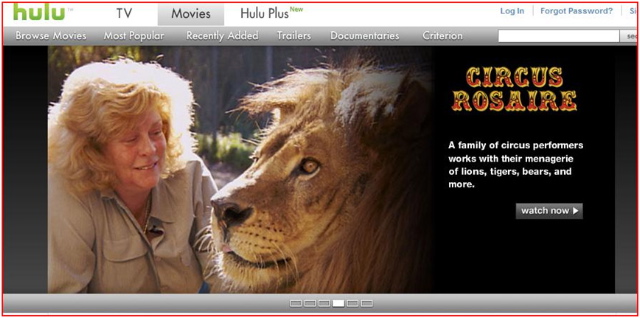
Recently, we were able to work with the website www.Jesse-Eisenberg.com to have them cross promote one of Jesse’s earlier films The Living Wake right after he was Oscar nominated for his work in The Social Network.
http://www.jesse-eisenberg.com/news/2011/01/29/the-living-wake-now-free-to-watch-on-hulu/
We also frequently collaborate with many of our filmmakers to heighten discussion, interaction and interest in many of our Hulu films.
c.) Social Media- Gravitas and its film partners are active users of Facebook and Twitter. Here is one example where are Documentaries on Demand partner PBS tweeted about the VOD release of The Buddha to its over 500 thousand followers.”
http://www.indiewire.com/article/gravitas_ventures_to_launch_documentaries_on_demand_with_pbs/
BRAINSTORM MEDIA
Brainstorm submitted this campaign plan in answer to our desire to what they do on the marketing front. They work with Eventful.
Eventful
What Would You Give Up to Find True Love?
Submit Your Answer for a Chance to Win!
One lucky winner and three guests will win a trip to NYC, stay at the
luxurious Kimberly Hotel, get a pampering spa day and more!
Campaign overview:
Eventful will execute a social media campaign to engage consumers around the film, My Father’s Will. The campaign will allow fans to submit their answers to win a trip to NYC, see submissions from other fans, and watch the trailer for My Father’s Will. Eventful will execute digital, email and social media marketing to drive campaign participation.
The goals of the campaign include:
- • Drive entries for the sweepstakes
- • Build awareness for My Father’s Will through trailer views
- • Build awareness for accommodations being provided, i.e. hotel
- • Generate social media and viral engagement for the film and sweepstakes
- • Create an engaged social community for direct marketing of VOD rentals of My
Father’s Will with including folder locations for each affiliate
Phase 1: Social media campaign – Win it!
1. Eventful will design, build and host:
- • Campaign micro-site including movie trailer and hotel branding
- • Custom widgets and social media apps for distribution across Facebook,
MySpace and other sites, enabling consumers to enter the sweepstakes
2. Eventful will execute a comprehensive targeted marketing and promotional plan to engage existing users from among Eventful’s audience of 16 million consumers:
- • Demographic targeting by location, age, gender, and entertainment tastes
- • Eventful will engage consumers via dedicated email, onsite promotions, and one-click social media sharing tools
3. Marketing by Eventful will drive participants to the campaign micro-site which will include:
- • Campaign artwork branded for My Father’s Will
- • Primary call-to-action to enter the sweepstakes by submitting an answer
- • Live stream of entries from fans
- • Official trailer for My Father’s Will
- • Campaign details with basic rules
- • Social media sharing tools for Facebook, MySpace, Twitter and email
Phase 2: Drive VOD rentals of My Father’s Will
1. Eventful will promote VOD sales for My Father’s Will through a digital and direct marketing campaign targeting all sweepstakes entrants plus a broader target audience within the Eventful user base. Campaigns include:
- • Dedicated email
- • Onsite promotions
- • Email newsletter insertions
Proposed Timeline:
- • “Win it!” Sweepstakes: 2/15/11 – 4/15/11
To see the campaign, access it here. http://movies.eventful.com/campaigns/myfatherswill2011
(TFC note: we look forward to hearing the outcome on this campaign)
—
So, in conclusion, you can see a range of what companies do. In general, some companies are more focused on consumer marketing and publicity and social network marketing than others and some are focused more on marketing to retailers and services and getting best placement and some may do both. We recommend the latter when you have a choice and of course, no one can market your film better than you can. In my experience most companies lack on the publicity side, though I will say First Run Features, for example, (since we did not cover them herein) seems to do a great job on that front working with a wonderful publicist, driving Netflix queue action, hiring outreach teams, posting the trailer all over, and take out ads, e-blast loads, as well as work social network sites etc.
I am sure other companies will want to chime in here about what they do and filmmakers too about their experiences, good or not-so-much. We want to hear from you so weigh in! Please offer specific examples, not just marketing speak. In the meantime, our resident social network marketing guru, Sheri Candler, has offered her take on what the above distributors have described.
Sheri Candler says: I am happy to see distributors explaining what they do to market titles under their control. Often, the text on their websites sounds like a generalization of typical activities conducted by any marketing department in any corporation. I urge filmmakers to press for a customized, detailed plan of EXACTLY what will be done on their films and how much it will cost. Ultimately, that cost will be deducted from your backend, so it is important to understand what you can expect from your distributor before you sign up with them. It also gives you an idea of what you will still need to do yourselves. This isn’t fix it, forget it and the money just rolls in.
As noted above, I think social networking activities by most distributors is minimal at best. If you already have 10K fans on your Facebook page and the distributor offering to perform social networking activities for your film only has 500, they really can’t offer much. Especially look at how they handle their pages. Is it mostly shill? Is there any engagement going on? Evaluate them on what they can bring you that you can’t do yourselves. I strongly disagree that distributors shouldn’t consider themselves consumer facing companies. All companies are consumer facing in this age of digital ubiquity. But if it is true, they aren’t consumer facing, most likely those distributors shouldn’t be using social media as a company at all. SOCIAL media is all about facing the customer and conversing with them.
The only impressive distributor in the above list with regard to social networking and utilizing it effectively is Independent Lens. Look at their page and see how they are using it. Very impressive. No wonder they have almost 70K fans. Ask if your distributor has a social media team (not 2 interns!) and ask to speak with those people to get a sense of what they will do with your title or how you can combine efforts effectively. Just getting a large entity to tweet about your title once is not going to do much; it is not a Twitter strategy.
Retail DVD placement (for the next few years anyway), iTunes, Netflix, and VOD marquee placement, relationships with major publications for reviews and feature stories, these are things a typical filmmaker cannot get on their own and are worth utilizing with a distributor. Sending out eblasts and unsolicited screeners to journalists is really spam; so if that is the extent of your distributor’s publicity efforts, it isn’t worth paying for. Be sure to ask EXACTLY which publications will be approached and evaluate whether those outlets reach your target audience. You should also be consulted on what story angles will be developed for the publications. This is especially necessary if you do not have notable stars or notable accolades from festivals attached to your film as publications will be more reluctant to cover it.
Since grassroots relationships were mentioned, press your distributor to name which organizations they work with. Are they just affiliate sales relationships? Are they just a member of the distributor eblast list? Real communication should be happening and for a relationship really to be fruitful, it has to be 2 way. Of the above mentioned distributors, only Wolfe strikes me as having actual relationships with target organizations. Their content is of value to the organizations they are affiliated with and I would venture a guess that Wolfe strongly champions the orgs cause and mission too. THAT is a relationship.
Advertising placement makes sense, but find out what the spend will be and what publications/sites. While I understand that distributors get better rates going with a media broker, the spend is wasted if the placements are in publications or on sites that do not reach your target audience.
My view on this is a distributor is a marketing partner. The bulk of what they should be bringing you is marketing prowess. Really dig into what their plans are for your film and ask to see examples of work on similar films. When deciding on which distributor to sign with, don’t just sign with someone offering you access to 15 million homes. It sounds great, but if few of those homes know your film exists, there won’t be many sales.
Orly Ravid March 2nd, 2011
Posted In: Digital Distribution, DIY, Marketing, Social Network Marketing, Uncategorized
Tags: community building, film marketing, self distribution
*This is Part II of the “If I Were a Filmmaker Going Sundance…”
*Part III to will be written in the aftermath of the glow of the fest.
Sundance 2011, insofar as distribution was concerned, saw a spike on both the traditional sales and the DIY front. 42 deals were done so far and more to come. One difference between this year’s Festival and those of recent years is that several acquisitions were done prior to the Festival and more deals occurred right at the beginning of the Festival rather than taken several days or weeks to materialize. In addition, some of the acquisition dollar figures were bigger than in recent times. There was a definite sense of ‘business is back’ (though mostly still for bigger films with either name directors or cast or both – and this we address below). And DIY is seeing a new dawn with directors like Kevin Smith announcing a self-distribution plan and Sundance’s solidified commitment to helping artists crowdfund (via Kickstarter) and market their films (via Facebook for example) access certain digital distribution platforms (in the works and TBA).
Starting with the deals. So far I counted 42 (one at least was a pre-buy / investment in production) and two so far are remake rights deals.
I only list the deal points that were publicized… meaning if no $$$ is listed then it was not announced.
Deals done Pre-Sundance:
1. Project Nim (James Marsh who did Man on Wire) – sold to HBO for a hefty yet unreported sum.
2. Becoming Chaz – produced by renowned World Of Wonder and sold to OWN (actually we gleaned OWN invested in the film and at the fest Oprah announced her commitment to doing for docs what she did for books via a Doc Club).
3. Uncle Kent went to IFC
4. The Greatest Movie Ever Sold (Morgan Spurlock) – went to Sony Classics.
5. Septien: (Michael Tully) – was nabbed by Sundance Selects
6. Mad Bastards also went to Sundance Selects
Deals done at Sundance according to sections:
US Dramatic Competition:
7. The Ledge: sold to IFC – Low seven figures
8. Like Crazy: (Director of Douchebag) – Paramount for a worldwide deal – $4,000,000.
9. Martha Marcy May Marlene: sold to Fox Searchlight, congrats to TFC Board of Advisor EXP, Ted Hope – 2 mil
10. Circumstance: Participant is funding the release and will (along with the filmmakers) choose a distribution partner, we hope Roadside Attractions.
11. Homework: Fox Searchlight – $3,000,000
12. Another Earth: (Mark Cahill) – Fox Searchlight – a $3 mil deal, with an aggressive P&A as reported and for US and all English speaking territories.
13. Gun Hill Road: Motion Film Group
14. Pariah: Focus Features – $1 mil deal
15. The Flaw: New Video
16. Take Shelter: Sony Pictures Classics
Premieres (‘names’ in films):
17. My Idiot Brother: TWC – $7,000,000 for US and key territories with $15,000,000 P&A
18. The Details: TWC – $7,500,000 MG and $10,000,000 P&A
19. I Melt With You: Magnolia (reported mid-high 6-figure deal reportedly w/ healthy backend)
20. Life in a Day: NatGeo Films
21. Margin Call: Joint deal with Lions Gate and Roadside Attractions – $2,000,000 deal
22. Perfect Sense: IFC
23. The Future: (Miranda July) – Roadside Attractions
24. Salvation Boulevard: IFC
25. The Son of No One: (Dieto Monteil) – Anchor Bay
26. The Devil’s Double: (Lee Tamahori) – Lionsgate – a reportedly seven figure deal
U.S. Documentary Competition:
27. Buck: Sundance Selects
28. The Last Mountain: Dada Films (MJ Peckos and Steven Raphael)
29. Page One: A Year Inside the New York Times: Magnolia and Participant
30. Hot Coffee: HBO
31. Crime After Crime: OWN (this will have an Oscar qualifying run before airing on OWN)
32. Miss Representation: OWN
33. The Black Power Mix Tape 1967- 1975: Sundance Selects
34. Sing Your Song: HBO Documentary Films
Doc Premieres:
35. These Amazing Shadows: Sundance Selects
Park City at Midnight:
36. Silent House: Liddell Entertainment
37. Hobo with a Shotgun: Magnolia/Magnet
38. Corman’s World: Exploits of a Hollywood Rebel: A&E IndieFilms
World Cinema Dramatic Competition:
39. The Guard: Sony Pictures Classics – $1,000,000 deal
Next:
40. Bellflower: Oscilloscope
Not distribution deals per se but Fox Searchlight bought worldwide remake rights to
41. The Bengali Detective
42. TWC bought remake rights to Knuckle.
Please let me know if I missed any deals and feel free to comment in this blog. Of course more may be announced even as this posts and I am on a plane.
So we see mostly name filmmakers or cast but also definitely a few non-names generating deals the details of which are not publicized thus far.
AND NOW ON the DIY side:
RE: SLITTING RIGHTS & DIY: Andrew Hurwitz and Alan Sacks wrote an article in the Hollywood Reporter addressing all the same stuff TFC has talked about before, splitting rights, working and sometimes conflating windows and not settling for bad deal terms when one could do better on one’s own working with consultants etc. It’s nice to see trades addressing this in a context that speaks to more traditional industry players.
THE FLAT FEE MODEL EXPANDS: Distribber (now owned by IndieGOGO) announced a partnership that has been brewing with one of our Cable VOD partners, and TFC Board of Advisor Meyer Schwarztein of Brainstorm Media. Basically it expands Distribber’s flat fee digital distribution offerings to include Cable VOD (and also Hulu). If a film gets onto all key MSOs the fee is set for now to be $9999 and there are prices per platform if a film cannot make it on to any given platform so that one is not paying for a platform or service they are not getting onto. As per the press release: “The films will be presented to audiences on the new “Filmmaker Direct” label; consumers who purchase films on “Filmmaker Direct” will know that 100% of profits go directly to the filmmaker, instead of to a parade of “Hollywood Middlemen.” For more info check out: http://www.distribber.com. My only cautionary note: this is not a great idea for smaller films for which the gross revenues that would not justify the flat fee. One must remember and always know to ask about the splits that the Cable VOD aggregator is getting from the MSOs. They range, to the best of my knowledge to-date, between 30% and 60% depending on company and films. Studios get the higher splits for the obvious reasons. And so one has to do the math. And of course also evaluate MARKETING (which will be the focus on the 3rd and final part of this Sundance Blog series). In any case, we work with both Adam Chapnick at Distribber and Meyer Schwarzstein at Brainstorm and are fond of and trust them both.
BRAND NAME FILMMAKER DIY: Kevin Smith fueled the torch of DIY in his own flame-filled way. He auctioned off the distribution of Sundance Premiere Selection RED STATE to himself and has pre-booked theatres and plans to be his own decider in distribution, sans print ads (Amen). We wish him well but caution his very “old world” production and release budget (4mil Prod & and 2.5mil to release (for prints etc)… immediate launch broad release plan… a slow build never hurt anyone. David Dinnerstein formerly of Paramount Classics and Lakeshore consulted on the release. For more on this topic just search the WWW.
ABOUT THE SHORTS:
DIY Hats off to the Sundance SHORTS filmmaker such as Trevor Anderson and I believe 11 others who are on Sundance’s YouTube Screening Room Initiative with tens of thousands of views. Anderson exceeded 94,000 views as of the other day and has put all his shorts including this year’s HIGH LEVEL BRIDGE on www.EggUp.com which allows him to monetize them via transactional digital sales. TFC refularly refers filmmakers to EggUp and now also TopSpin though our guru Sheri Candler advises TopSpin works better for filmmakers with an already robust following. Whilst Anderson may not be getting rich just yet, it’s a perfect model for a prolific and vibrant filmmaker who is building a brand and getting his/her work out there.
Last but not least, Sundance announces its DIY oriented initiative.
Sundance Institute announced (I’m now quoting from its press release) its “Three-Year Plan with Kickstarter as Creative Funding Collaborator / Facebook® to Provide Guidance to Institute Alumni… A new program to connect its artists with audiences by offering access to top-tier creative funding and marketing backed by the Institute’s promotional support…The creative funding component was announced today with Kickstarter, the largest platform in the world for funding creative projects. A new way to fund and follow creative projects, tens of thousands of people pledge millions of dollars to projects on Kickstarter every month. In exchange for support, backers receive tangible rewards crafted and fulfilled by the project’s creator. Support is neither investment, charity, nor lending, but rather a mix of commerce and patronage that allows artists to retain 100% ownership and creative control of their work while building a supportive community as they develop their projects… In the coming months, Sundance Institute will build an online hub of resources related to independent distribution options, funding strategies and other key issues. The goal is to provide for filmmakers a central location to explore case studies and best practices, in addition to live workshops and training opportunities with Institute staff, alumni, industry experts and key partners. As the first of these partners bringing their expertise to the community, Facebook will offer Institute alumni advice, educational materials, and best-practices tips on how to build and engage audiences via the service…Further development will include access to a broad and open array of third-party digital distribution platforms backed by Sundance Institute promotional support. In the future, additional opportunities for theatrical exhibition will be explored in collaboration with organizations such as Sundance Cinemas, members of the national Art House Project, and others.”
I have been championing festivals getting involved with exhibition since and distribution beyond the festival itself since 2005 and discussed some options and ideas with Sundance staffers last year and am thrilled about this powerful and liberating announcement that so connects up with TFC’s mission whilst having some serious muscle and we look forward to being involved in some way hopefully.
MARKETING IS KING: One thing no one talks about in much detail is MARKETING. Of course the big guns have the cash to buy marketing but the small distribs and aggregators are starting to be difficult to distinguish at times, and yet sometimes distributors do earn their fees by investing real talent and expertise and even money in marketing. So comparing what one can do oneself (if one does not get the big fat offer) with what traditional but small distribution deals bring will be the focus of the 3rd and last post in this series to come after Rotterdam but hopefully before Berlinale.
Over and out for now. Questions and Comments always welcome!
Orly Ravid January 27th, 2011
Posted In: Digital Distribution, Distribution, DIY, Film Festivals, Marketing
Tags: Digital Distribution, distributors, film distribution, Film Festivals, film marketing, independent film, Kickstarter, Sundance
As previously stated, many distributors will have marketing procedures in place to help sell your film when it is ready for distribution. The true use of a social networking strategy comes long before your film is ready for distribution.
A social networking strategy will take many months to a year to implement and it will be an ongoing effort. This effort starts with you and your team first. You will determine whom you are trying to attract into your community and what you have to offer them of interest. It is NOT all about your film, in fact very little direct mention of your film is best. Follow the 80/20 rule, 80% of your assets are about the interests of your audience, 20% of your assets are telling them about the film. You will build your engagement pages and populate them with interesting and valuable content. You will not be asking your supporters for ANYTHING, merely building a solid base of supportive fans who will be there when you are ready for distribution.
You should never do anything that will make them feel that you have formed the community in order to use it for your own purposes. Companies and filmmakers who do this stand to ruin the very thing they have spent so much time developing; a genuine and authentic community that is very loyal and connected to you and your film. That kind of loyalty is extremely difficult to accomplish with advertising and it is really the ultimate goal of all brands.
Orly Ravid August 13th, 2010
Posted In: Marketing, Social Network Marketing
Tags: 80/20 rule, distribution, film marketing, social networking, strategy, The Film Collaborative
Plant your marketing and distribution seeds at pre-production / production stage. Think about your audience in advance of making your film and think about your title carefully from a marketing point of view too. Do a little research to see if the title has been used recently and might cause confusion with another film currently in the market.
Buy up all related and possibly desired urls and start on the site, draw in traffic and collect names and contact info. Make sure your set photography is top-notch from a marketing and publicity point-of-view. Start building community around your brand as a filmmaker and the film itself, and possibly even sharing parts of the content with your future audience.
TFC has a marketing services menu that includes options for access to a DIY Marketing Toolkit to guide microbudget filmmakers in their own marketing initiatives.
Orly Ravid August 2nd, 2010
Posted In: Film Festivals, Marketing, Social Network Marketing
Tags: branding, DIY Marketing Toolkit, Film Festivals, film marketing, film title, independent film
It is no longer enough to just make a film, you have to create community and anticipation for your film as well. And social media and viral outreach takes a long time to reach critical mass, so build your social media presence into your production schedule.
Just this week a filmmaker asked us…”I’m in post-production, should I wait for a distributor or start thinking about marketing now?” The answer? — do not wait for anyone! By the time you exhibit your film at a film festival you should already have built a community so that you can make the most of your public exhibition and be best positioned to distribute your film effectively and as directly as possible… And it also so happens that distributors these days are looking at your number of facebook friends and your twitter followers to help them make acquisition decisions….as it helps them gauge interest in your film.
But even more pointedly, one’s ability to get onto Cable VOD will be impacted by perception of marketing and audience interest and that’s still the lions share of revenue stream in digital and very competitive, and for when your film is available on DVD and digitally, you’ll have a community to distributed to. Think of your film as a cross-platform story, and allow your community to access it from whatever medium they choose…that way when the film is finally finished they’ll be primed to see it. So don’t procrastinate….start letting people know about your film NOW.
Orly Ravid July 26th, 2010
Posted In: Facebook, Film Festivals, Marketing, Social Network Marketing
Tags: film distribution, Film Festivals, film marketing, independent film, social media, VOD
« Previous Page















